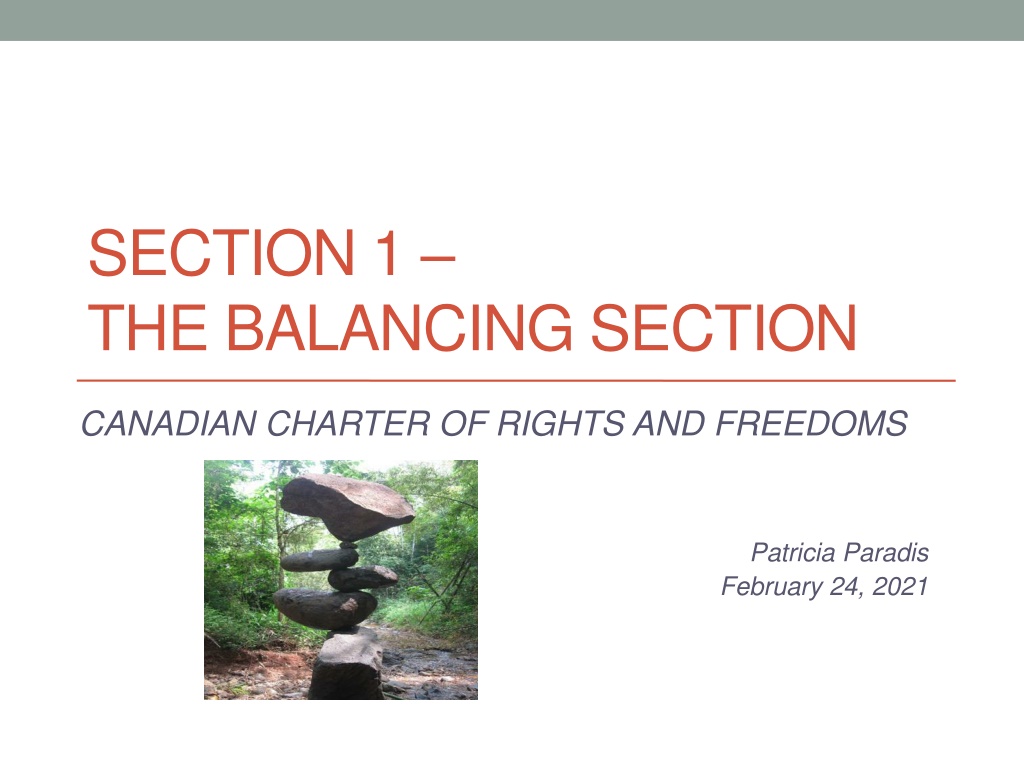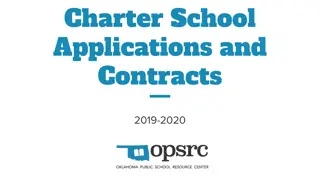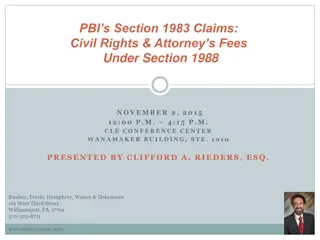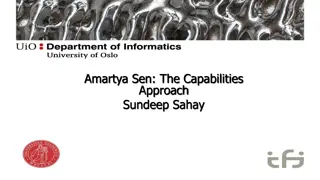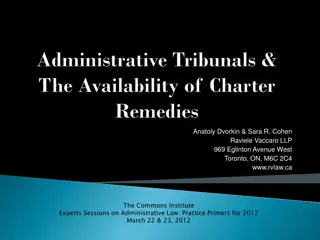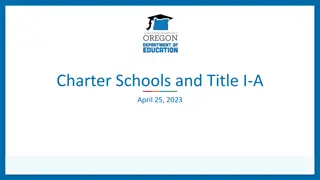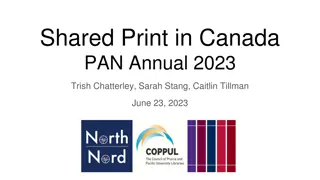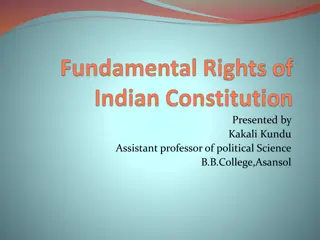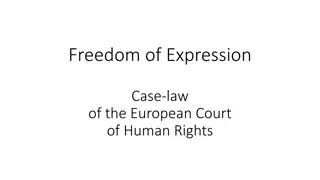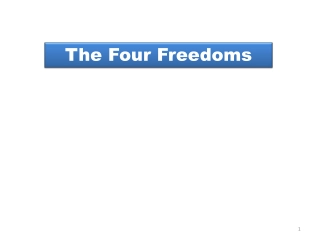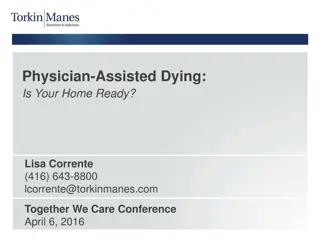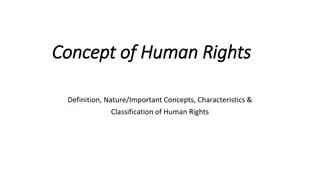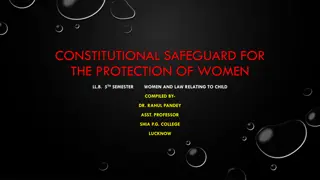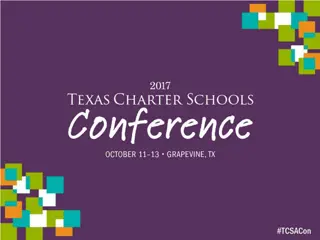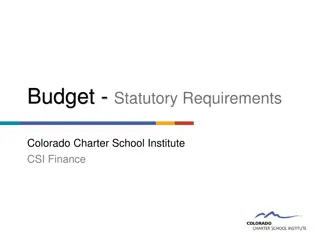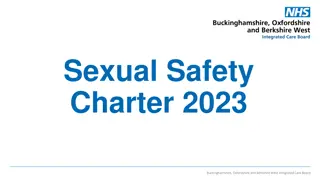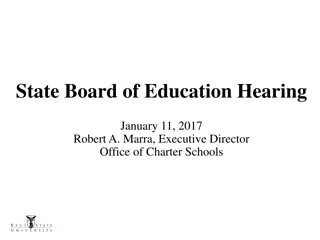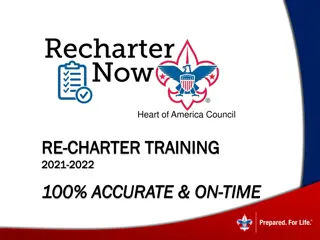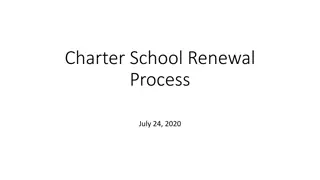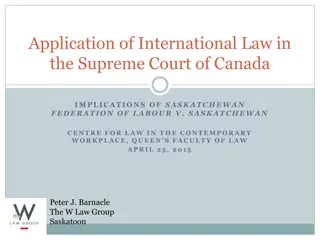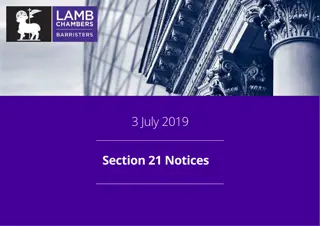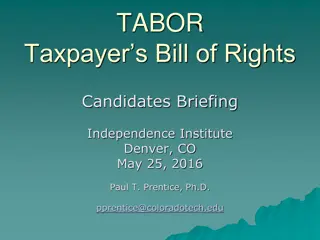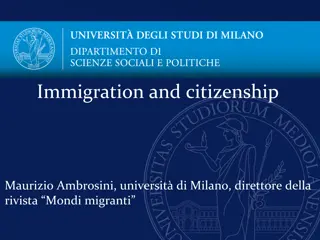Understanding Section 1 of the Canadian Charter of Rights and Freedoms
Exploring the history, purpose, and interpretation of Section 1 of the Canadian Charter of Rights and Freedoms. This section discusses the balancing act of limiting rights for societal well-being, notable events like the Hays-Joyal Joint Committee hearings, and perspectives from individuals like Alan Borovoy. Dive into the significance and implications of Section 1 within the legal framework in Canada.
Download Presentation

Please find below an Image/Link to download the presentation.
The content on the website is provided AS IS for your information and personal use only. It may not be sold, licensed, or shared on other websites without obtaining consent from the author. Download presentation by click this link. If you encounter any issues during the download, it is possible that the publisher has removed the file from their server.
E N D
Presentation Transcript
SECTION 1 THE BALANCING SECTION CANADIAN CHARTER OF RIGHTS AND FREEDOMS Patricia Paradis February 24, 2021
Agenda 1. What this presentation will not cover 2. History of section 1 3. Purpose 4. Approach to interpretation used by the courts 5. Examples of its prior use 6. Scenarios for its future use hypotheticals
Anatomy of the Charter Part 1 of the Constitution Act 1982 Limitations clause section 1 Rights and Freedoms sections 2 23 Remedies section 24 General provisions re: interpretation sections 25 31 Application - section 32 Notwithstanding Clause section 33 Name section 34
Section 1 - Why Limit Rights? Some rights and freedoms may have to be curtailed for the good of society as a whole Rights and Freedoms in the Charter cannot be absolute Cannot willfully incite hate against identifiable groups hate is the type of expression that can be limited
History of section 1 1960 s drafts aimed at preserving provincial legislative jurisdiction provinces opposed to a charter of rights 1978 Bill C-60 Clause 25 Public safety, health, peace and security of the public, interest of the rights and freedoms of others - International human rights instruments 1980 - Mack Truck Clause : The Canadian Charter of Rights and Freedoms guarantees the rights and freedoms set out in it subject only to such reasonable limits prescribed by law as are generally accepted in a free and democratic society with a Parliamentary system of government
Borovoy and Epp comments Alan Borovoy, General Counsel for the Canadian Civil Liberties Association: If you are talking about that which is generally accepted in a free and democratic society with a parliamentary form of government, you may well be talking about everything that Parliament or the legislatures have said is acceptable and to the extent that you are doing that, then it renders the entire charter a verbal illusion Do I undertand you correctly, that if the document before us were to be enshrined, entrenched, that an incident like Canadians of Japanese origin and the removal of these people from various parts of Canada, their prohibition of freedoms at that time, that in fact that kind of action would still be possible under the charter in its present form?
Limitations Clause Section 1 Joint Committee (Hays-Joyal) 1981 - Addition of reasonable and demonstrably justified ensured accountability and requirement for a greater level of justification from government Section 1 Final wording: The Canadian Charter of Rights and Freedoms guarantees the rights and freedoms set out in it subject only to such reasonable limits prescribed by law as can be demonstrably justified in a free and democratic society.
How to interpret? Section 1 - The Canadian Charter of Rights and Freedoms guarantees the rights and freedoms set out in it subject only to such reasonable limits prescribed by law as can be demonstrably justified in a free and democratic society. 1. Reasonable limits? what is a reasonable limit? 2. Prescribed by law? what exactly does that mean? 3. Demonstrably justified? how do you demonstrably justify ? Ask the court!
First things first: 1. The Court must first find a breach of a section of the Charter by a government law. Onus on rights claimant to establish the breach of a Charter right Prescribed by law ensures rules are known, legislative debate has taken place 2. Then the government has the opportunity to justify its law before a court, using section 1 of the Charter the justification clause Court must determine whether the breach is reasonable and justifiable in a free and democratic society
Section 1 Case -1986 R v Oakes David Edwin Oakes found with small amount of hash oil, charged with possession for the purpose of trafficking Section 8 of Narcotic Control Act stated that possession meant the intent to traffic amount of drugs irrelevant Onus is on accused to prove there is no intent to traffic Potential for life imprisonment unless no intent Pleads not guilty and challenges the law as a breach Charter section 11 d) right to be presumed innocent until proven guilty
The Breach of a Charter right The Court finds that section 8 of the Narcotic Control Act is a BREACH of section 11 d) of the Charter (right to be presumed innocent until proven guilty) because: o Mr. Oakes is PRESUMED GUILTY of having the INTENT to traffic, rather than presumed innocent - the Crown Prosecutor must establish his guilt o The amount of drugs in Mr. Oakes possession is irrelevant o Oakes must prove he had no intent to traffic this is a reverse onus. He must prove that he is innocent o Reverse onus presumption for the purposes of trafficking violates the presumption of innocence a Charter protected right.
Section 1 the justification The Canadian Charter of Rights and Freedoms guarantees the rights and freedoms set out in it subject only to such reasonable limits reasonable limits prescribed by law by law as can be demonstrably justified justified in a free and democratic society demonstrably The Court had to interpret section 1 of the Charter so that it could balance the breach of section 11 d) with government s arguments for justifying section 8 of the Narcotic Control Act.
The Test section 1 Oakes Test 1986 SCC 1. Law must have pressing and substantial objective 2. Means chosen by the government to limit rights must be proportional to burden on rights: a) Objective of the law must be rationally connected to the law b) Limit/law must minimally impair the Charter right c) Means must balance effects - Overall balance or proportionality between benefits of the limit (law) and its harmful/deleterious effects on the right. Costs to rights holders vs benefits of the government law
Oakes Test 1. Pressing and substantial objective: Purpose or Objective must be important to society. Must be of sufficient importance to warrant overriding the right or freedom Oakes case the purpose or objective of section 8, NCA is to prevent drug trafficking and ensure health and safety of the community Pressing and substantial objective? Yes
Oakes Test Law has a pressing and substantial objective 2. Means used must be proportional to burden on rights: Objective must be rationally connected to the law Limit must minimally impair the Charter right Must be overall balance or proportionality between benefits of the limit and its harmful effects. a) b) c)
Oakes Test a) rational connection a) Limitation/law must be rationally connected to the objective of the law Law cannot be arbitrary, unfair or based on irrational considerations Oakes case: Objective of the law: to prevent drug trafficking promote health and safety of the community No Rational Connection between objective and the law. Irrational to assume intent to traffic because a person is in possession of drugs Rational Connection? No
Oakes Test 1. Law has a pressing and substantial objective 2. Means used must be proportional to burden on rights: XObjective must be rationally connected to the law Limit/law must minimally impair the Charter right Must be overall balance or proportionality between benefits of the limit and its harmful effects. Result: Section 8 of the Narcotic Control Act unconstitutional - struck down
Oakes Test b) minimum impairment b) Limitation/law must minimally impair the Charter right The law must impair the Charter right as little as reasonably possible. If there is another, less impairing way to achieve its objective, government must choose it within reason Example: Ford v Quebec (1988) Quebec laws requiring exclusive use of French on signs breach freedom of expression - Charter section 2 b) fail Oakes test at minimal impairment stage: other less drastic means of protecting French language. Law is struck down
Oakes Test c) proportionality Balancing between overall benefits and harmful effects of the law c) State Action vs Charter right It remains possible that the severity of the deleterious (negative) effects of a law will not be justified by the purposes it is intended to serve, even if the objective is of sufficient importance, the measures rationally connected and the impairment a minimum. this final step allows courts to stand back to determine whether a rights infringement is justified in a free and democratic society. Although this examination entails difficult value judgments, it is preferable to make these judgments explicit, as doing so enhances the transparency and intelligibility of the ultimate decision. Further, proceeding to this final stage permits appropriate deference to Parliament s choice of means, as well as its full legislative objective . (Oakes)
Hutterian Brethren Case - 2009 Alberta law requiring photos on driver s licenses breaches section 2a) of Charter freedom of religion Can the law be justified using section 1 of the Charter? 1. Pressing and Substantial objective? Purpose of the law: maintaining the integrity of the driver s licensing system in a way that minimizes the risk of identity theft - yes 2. Proportional? a) Rational Connection Objective rationally connected to law b) Minimal Impairment Yes. Reasonably tailored to address problem of identity theft associated with drivers licenses c) Balance of burden and benefit Negative impact on freedom of religion does not outweigh benefits to society of system that minimizes identity theft. Law is justified.
Oakes Test Section 1 1. Law must have pressing and substantial objective 2. Means used must be proportional to burden on rights: Objective must be rationally connected to the law or policy Limit must minimally impair the Charter right Must be overall balance or proportionality between benefits of the limit/law and its deleterious effects. a) b) c)
Cases/laws failing Oakes test R v Morgentaler Section 7 breach. Norational connection b/n protection of women s health and therapeutic abortion process requiring approval from 3 physicians for abortion. Law struck down R v Nur Section 12 breach - right not to be subjected to cruel and unusual punishment. 3-year sentence (mandatory minimum) for possession of an illegal weapon. Not minimally impairing (step 2 b). Other ways to achieve objective of deterrence for possession of illegal weapons. Law struck down R v Carter Section 7 breach. Life, liberty, security of the person. Law that absolutely prohibits physician-assisted dying is not minimally impairing. Law struck down
Pandemic Issues Federal Government mandates hotel quarantine mandates hotel quarantine upon entry COVID-19 Emergency Orders in Council (OIC) pursuant to section 58 of the Quarantine Act in effect in effect - - makes the annexed Minimizing the Risk of Exposure to COVID-19 in Canada Order (Quarantine, Isolation and Other Obligations). Newfoundland Government prohibiting entry Taylor case Limitations on indoor gatherings including church services
Federal Restrictions: Air traveller requirements: Travellers must provide proof of a negative COVID-19 molecular test taken up to 72 hours before their scheduled departure time. As of February 21, 2021, at 11:59 pm ET, travellers, unless exempted, will also be required to: o reserve a government-authorized hotel for 3 nights prior to departure to Canada o take a COVID-19 molecular test on arrival in Canada o stay in the government-authorized hotel while awaiting the results of the COVID-19 molecular test taken on arrival o pay for the cost of the hotel stay, as well as all associated costs for: Food, security, transportation, infection prevention and control measures Travellers must present proof of having reserved and pre-paid for their accommodation through ArriveCAN. Travellers will still be required to complete the remainder of the mandatory 14-day quarantine after their mandatory hotel stopover.
The OakesTestsection 1 Law Law Quarantine Act, section 58 Breach Breach possible section 7 Charter breach life, liberty, security of the person Section 1 Justification Section 1 Justification 1. 1. Pressing and substantial Pressing and substantial objective? 2. Means chosen must be proportional proportional to burden on rights: Objective must be rationally connected rationally connected to the limit on Charter right Limit must minimally impair minimally impair the Charter right Overall balance balance or proportionality proportionality between benefits of the limit and its deleterious effects. Means must balance effects a) b) c)
Oakes Part 1 Pressing and Substantial Objective? Government purpose as stated on its website will likely be found to be pressing and Government purpose as stated on its website will likely be found to be pressing and substantial: substantial: Whereas the Governor in Council is of the opinion, based on the declaration of a pandemic by the World Health Organization, that there is an outbreak of a communicable disease, namely coronavirus disease 2019 (COVID-19), in the majority of foreign countries; Whereas the Governor in Council is of the opinion that the introduction or spread of the disease would pose an imminent and severe risk imminent and severe risk to public health in Canada; Whereas the Governor in Council is of the opinion that the entry of persons into Canada who have recently been in a foreign country may introduce or contribute to the spread of the disease in Canada or new variants of the virus causing COVID-19 that pose risks that differ from those posed by other variants but that are equivalent or more serious; And whereas the Governor in Council is of the opinion that no reasonable alternatives to prevent the introduction or spread of the disease are available alternatives to prevent the introduction or spread of the disease are available no reasonable
Part 2 a) rational connection? Objective Objective: To limit the spread of COVID-19, entry of persons into Canada who have recently been in a foreign country may introduce or contribute to the spread of the disease in Canada or new variants of the virus causing COVID-19 that pose risks that differ from those posed by other variants but that are equivalent or more serious OR Objective Objective To discourage Canadians from travelling abroad, and to discourage travellers generally from entering Canada Law: Law: Negative COVID19 test taken within 72 hours before Government-approved hotel for 3 nights At the traveler s expense: All expenses for food, security, transportation, infection prevention and control measures Provide proof of hotel reservation and pre-payment Required to complete 14-day mandatory quarantine after 3-day hotel stay and negative test 1. 2.
Problems with the law May discourage non-essential travel, but, in terms of preventing COVID spread: o 3-day stay in hotel is not long enough to catch every potential infection. Incubation is 5-7 days. Only sufficient to process PCR test; o Those vaccinated in the US are still subjected to the process of booking and paying for a hotel for 3 days; o No controls in place for moving international travellers from the airport to quarantine hotels can use taxis, shuttles, their own cars. Might stop along the way; o Hotel staff have to ensure travellers stay in their hotel rooms. Limited training for preventing of infectious diseases; o Essential workers such as truck drivers and health care workers exempted from 3-day hotel stay at the border
Part 2 b) minimum impairment? Is a mandatory 3-day hotel stay the least drastic way to achieve the objective? o Stop spread from countries outside Canada o Discourage travel outside Canada o Catch disease quickly from other countries Other options? o Regular checks on those who are isolating at home o Exemptions for those who are vulnerable the elderly, those with disabilities o Mandatory 14-day stay in gov t facility as in other countries such as Australia
Part 2 c) balancing/proportionality Importance of weighing costs to rights holders against benefits of the government law or policy Life, liberty, security of the person important Charter rights Balance against: The 3-day mandatory hotel stay, enormous emotional cost to some vulnerable people, high actual cost, doesn t seem to meet the government s objective of reducing COVID spread
Taylor v Newfoundland, 2020 NLSC 125 Restriction of mobility between provinces prohibiting entry to Newfoundland Ms. Taylor wanted to attend her mother s funeral. Sought an exemption from the travel restriction imposed by Nfld, but was denied entry Public Health Protection and Promotion Act orders restricting those permitted to enter Ms. Taylor filed a Charter challenge - section 6 mobility rights, and section 7 rights to life, liberty and security of the person Court finds section 6 breach - Mobility rights include the right to move within Canada
Section 1 Is the breach of section 6 justifiable? Preliminary comments: Yardstick by which the travel restriction is to be measured are the values and principles essential to a free and democratic society Context has been described as the indispensable handmaiden to the section 1 analysis need to canvass the nature of the social problem that the legislation addresses Legislature is not required to provide scientific proof based on concrete evidence of the problem it seeks to address in every case (Harper) Court can rely on logic, reason, and the application of common sense to what is known
Objective Reasonable and Justifiable? Objective: To protect those in Nfld and Lab from illness and death arising from importation and spread of COVID-19 by travelers Applicant argues that the real objective is to flatten the curve by preventing non-residents, such as Ms. Taylor, from entering the province. Restriction unnecessary because of few cases Court disagrees Evidence from experts that when small # of cases, just a few imported cases may double the number of active cases Growth rate of COVID-19 exponential in populations with little immunity Restrictions were introduced to protect from importation and spread Concern that people might come to Nfld to avoid COVID-19
Rational Connection? Objective: To protect those in Nfld and Lab from illness and death arising from importation and spread of COVID-19 by travelers Court finds there is a rational connection between the Orders to restrict entrance to Nfld and Lab and the objective Empirical evidence is not necessary to establish a rational connection, but government provided convincing evidence of the effectiveness of the travel restriction
Minimally Impairing? Court are there reasonably feasible and less impairing alternatives to achieve the same objective (454) Business of government is a practical one With benefit of hindsight it is possible for imaginative counsel to posit alternatives. Resourceful counsel can multiply the alternatives (455) Courts do not have expertise to second guess decisions of public health officials (458) Public health response to COVID-19 evolving consider April 2020 Public health response is to err on the side of caution No one-size fits all. Provincial responses differ given populations Self isolation not reliable - not viable substitute for travel restriction Testing of incoming travelers cannot be relied upon (30% failure) Contact Tracing does not prevent importation of COVID-19 but useful in conjunction with travel restrictions Travel restrictions aimed at non-essential travel are regularly reassessed
Balancing Objective with Effects Is there proportionality between: the negative effects of the travel restriction on mobility rights and the positive objective - to protect those in Newfoundland and Labrador from illness and death arising from importation and spread of COVID-19 by travelers Court: Question is, whether the harm done by restricting travel to the province outweighs the benefit to the public gained through the prevention, or at least the reduction of COVID-19 in the province. To ask the question is to answer it . The collective benefit to the population as a whole must prevail"
Considerations Is better safe than sorry ok for a democracy that protects fundamental rights? Court should not give too much deference to the government especially during a pandemic Arbitrariness Taylor s sister could have entered, but not Taylor Measures that are considered reasonable at one time, may not be in another
Grace Life vs Alberta Government Church refuses to accept Alberta Government s orders restrict gatherings to 15% occupancy: Government indifferent to societal harms of lockdowns depression, deprivation of congregants ability to practice their religion They obey their GOD not Government Argue their Charter protected freedom of religion is violated, and restrictions are not justifiable
Breach and Justification -hypothetical 1. Breach of Charter section 2 a) freedom of religion, 2 c) freedom of assembly, because of Government restrictions on in-person worship gatherings 2. Is the Alberta Government law restricting gatherings reasonable and justifiable?
Govt restrictions on in-person gatherings Oakes Test Oakes Test Gov t justification (potential) Gov t justification (potential) To reduce spread of COVID- 19 Health, safety Proportional? Limiting the number of people who can gather will reduce the spread Given the science, and numbers of COVID cases, this is the safest approach Protection of the public more important than freedom of religion for a small group 1. Pressing and substantial objective? 2. Proportional? Rationally connected Minimally impairing Balance of harmful effects vs objective 1. 2. a) a) b) c) b) c)
Govt restrictions on in-person gatherings Gov t Justification (potential) Gov t Justification (potential) To reduce spread of COVID-19 Health, safety Proportional? a) Limiting the number of people who can gather will reduce the spread b) Given the science, and numbers, there are no other reasonable measures available c) Protection of the public more important than freedom of religion for a small group Church Arguments (potential) Church Arguments (potential) To reduce spread of COVID-19 by limiting numbers to 15% Proportional? a) No rational connection - 15 % is arbitrary. No evidence to support reduction of spread b) Not minimally impairing. Effects on congregants severe. No science to support this restriction. COVID is like flu c) Not proportional - Freedom of religion is a critical freedom. Deleterious effects on ability to practice faith far outweigh perceived risks of spread 1. 1. 2. 2.
Section 1 Concluding Thoughts Oakes test has withstood test of time (35 yrs) Legislative branch and judicial branch meet at section 1 Critics charge that the section allows too much judicial morality esp. final stage May be less deference to government as new evidence on the pandemic emerges and vaccines are more prevalent
